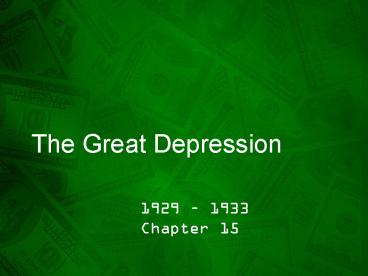The Great Depression PowerPoint PPT Presentation
1 / 21
Title: The Great Depression
1
The Great Depression
- 1929 1933
- Chapter 15
2
Section 1 Pg. 442What you need to know
- Explain the warnings that financial experts
issued about business practices in the 1920s - Causes of the stock market crash in 1929.
- How did the banking crisis and business failures
point to the beginning of the Great Depression? - Main Causes of the Great Depression
3
1 Warnings from experts
- Danger !!
- Farm crisis
- Sick Industries
- Reliance on credit buying goods without
actually paying money - Buying/Selling stocks quickly ? inflated stock
prices - Margin Buying
4
2 Stock Market Crash
- Once the stock market starts to fall, can
anything reverse the decline?
1. Rising Interest rates and other factors worry
investors.
- Investors sell stocks.
3. Stock prices go down.
4. Heavy sales continue.
CRASH
5
3 Banking Crisis ? Depression
How do Banks Make ??
- Borrowers could not pay loans default
- Banks left with little
- Depositors panicked and tried to take life
savings out. - 1930-1932 ? 5,000 banks failed.
6
3 Business Failures ? Depression
- GNP Gross National Product total value of
goods and services produced in a given year. - 1929 103 Billion
- 1933 56 Billion
- Industry lost money in the stock market
- Consumers did not buy
- NO MORE USING CREDIT!
- Forced companies to have less inventory, scale
back making products, lay off employees or go
bankrupt.
7
4-Causes of Great DepressionPg. 5 in Packet
- Global finances after WWI
- Others paying war debts ? buying American goods
- Smoot-Hawley Tariff
- Few people had wealth, many had debts.
- No buying power
- The Business Cycle
- The normal ups and downs in a free-enterprise
economy
8
Hard Times
- Section 2 Page 448-455
9
What you need to know
- Describe how unemployment affected the lives of
workers during G.D. - Compare/Contrast hardships between urban and
rural citizens. - How G.D. affected family life and American
attitudes. - Explain how popular culture provided an escape
from G.D.
10
1-Unemployment affected lives
- Everyone in America was looking for work.
- 1929 1.5 Million unemployed
- 1933 15 Million unemployed
- Wages ?
- Hours ?
- Immigration ?
- Discrimination ?
- Women working ?
11
2 Life in the city
- Unemployment Poverty
- Fighting over scraps
- Groups tried to provide to the needy
- Salvation Army, Red Cross, mutualistas, rent
parties - Breadlines
- Eviction ? Shantytowns / Hoovervilles
12
2 Life in the country
- Prices ? - Who could buy?
- Too many products
- Income ? - Foreclosing farms
- Pressured migrant workers to leave
- Dust Bowl drought in some states
13
3 Family life attitudes
- Fractured some families / forced some families
together - Divorce ?
- Birthrates ?
- Depression was the mood 28 increase in suicide
in 1932 over 1929 - Shame for middle-class / wealthy
- Made every penny count made as much as they
could
14
4 Culture Escape
- Took up inexpensive hobbies
- Reading, games, movies, radio
- Literature presented heroes and easy lives /
others portrayed grim life - VIDEO
15
What did the Government Do??
- Hoovers Policies
- Section 3 Page 456-463
16
What you need to know
- Explain why Pres. Hoover opposed government
sponsored relief for the needy. - Outline Hoovers attempts to solve economic
problems and analyze the successes. - Explain how veterans and radicals responded to
Hoovers policies. - Why was FDR a popular candidate in the 1932
election?
17
1 Opposition to Government Relief
- REASONS NOT TO HELP
- Relief would create large government
- Inflate the federal budget
- Reduce self-respect of people getting aid
- INSTEAD
- Rugged Individualism success through individual
effort and private enterprise - Encouraged voluntarism PCUR ? Presidential
committee collected info and donations for local
relief agencies
18
2 Government Economy
- Laissez-faire approach to economy
- Funded several public-works programs
- Stimulated business reduced unemployment
19
2 Government Economy
- Established Federal Farm Board
- GOAL Find ways for farmers to help themselves
- OFFERED loans, financed cooperatives to reduce
expenses by allowing them to purchase in bulk - Established Reconstruction Finance Corporation
- Loaned tax payer money to stabilize banks,
insurance companies, railroads - Government realized that they could do something
to help the economy
20
3 Radicals / Veterans Protested
- Condemned capitalism felt it led to G.D.
- Bonus Army group that wanted early payment of
pension bonuses owed to them - Bill was rejected and caused deadly conflict!
21
4 1932 Election
- Rep. Herbert Hoover vs. Dem. F. D. Roosevelt
- Hoovers gloom vs. Roosevelts optimism
- Roosevelt pushed for a fairer distribution of
wealth - Roosevelt had designed creative relief programs
as governor of NY.

